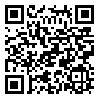BibTeX | RIS | EndNote | Medlars | ProCite | Reference Manager | RefWorks
Send citation to:
URL: http://jccnc.iums.ac.ir/article-1-121-en.html
2- Department of Critical Care Nursing, Faculty of Nursing and Midwifery, Iran University of Medical Sciences, Tehran, Iran. ,
3- Department of Biostatistics, School of Public Health, Iran University of Medical Sciences, Tehran, Iran.
Background: Shift report in nursing profession comprises the collection of information, assessment of nursing cares provided to hospitalized patients, providing an opportunity to get acquainted with patients, and being aware of their caring process. This study aimed to investigate the effect of educating nurses in intensive care units on the reporting of work shift using the SBAR tool.
Methods: The present study is quasi-experimental and interventional. It was conducted with pre/post training and one-group design. The study was an observational study done by the researcher using a checklist based on SBAR tool. The samples were recruited by census sampling method in the intensive care unit of Hazrat Rasool Hospital, affiliated to Iran University of Medical Sciences. Work shift delivery report was observed using the 18-item SBAR checklist by the researcher once before training reporting (3 work shift delivery reports from each nurse) using the SBAR tool and once after training (3 work shift delivery reports from each nurse). In training sessions, reporting method was taught to nurses in the unit based on SBAR tool. After one month of training, nurses’ performance in reporting delivery of work shift was evaluated in accordance with the above tool. The collected data were analyzed using SPSS V. 20.
Results: Comparison of the performance of nurses in intensive care units before and after work shift delivery report training using the SBAR tool showed a significant statistical difference between the performance scores in all areas before and after the intervention and the scores increased after intervention.
Conclusion: Using the shift work reporting method had a significant effect among the study participants using SBAR tool and improved their performance with regard to work shift delivery report.
Received: 2016/10/1 | Accepted: 2017/08/20 | Published: 2017/12/31
| Rights and permissions | |
 |
This work is licensed under a Creative Commons Attribution-NonCommercial 4.0 International License. |





